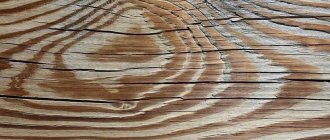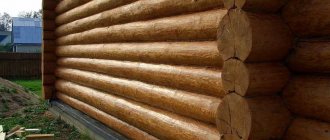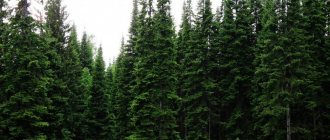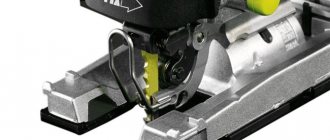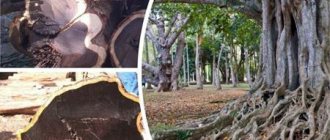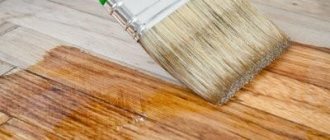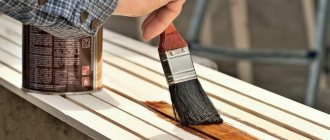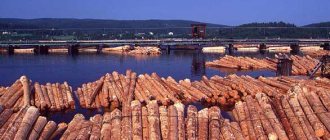How to choose impregnation based on wood type
To select a good impregnation, several factors are taken into account. The first of these is the type of wood. First of all, it is important for antiseptic impregnations, because different types of wood have different resistance to bacteria and fungi:
- unstable (alder, aspen, linden sapwood, birch kernel);
- weakly resistant (maple, oak, beech sapwood, birch sapwood, elm core);
- medium-resistant (larch, spruce, fir, cedar sapwood);
- resistant (pine, ash, larch core, oak core).
When choosing an antiseptic impregnation for wood against moisture, mold and rot, you need to take these indicators into account. The “weaker” the tree, the more “aggressive” impregnation is needed.
In addition, different types of wood have different absorption characteristics. For stubborn, dense rocks, it is worth choosing an impregnation that can penetrate deep into the material:
- poorly absorbent (spruce, oak kernel, ash kernel, beech kernel);
- medium (alder, aspen, linden, maple sapwood, pine core);
- highly absorbent (birch, beech, pine sapwood).
Also, the type of wood is important for decorative impregnations, because they emphasize the texture and improve the appearance of the material. Accordingly, dark impregnation is not suitable for light breeds and vice versa.
Other criteria for choosing impregnation when processing wood for home and outdoor use:
- purpose of use (against bacteria, moisture, fires, sun, frost, etc.);
- composition (aqueous, alcoholic or oily, organic or chemical);
- environmental friendliness (for internal processing it is very important, for external processing it can be sacrificed for the sake of higher efficiency);
- decorative (there are impregnations with color or filler to create texture);
- consumption (different compositions have different consumption rates per square meter).
Sometimes (for example, for technical rooms) you can buy cheap impregnation, but more often than not, it’s better not to save money. Budget products have a higher consumption - they need to be applied in 3 or more layers, while 2 layers are enough for high-quality impregnation. As a result, there is either no saving at all or it is insignificant.
Senezh Bio
If you need the best impregnation of wood against rotting, then Senezh Bio will effectively cope with the task, while protecting the structure from blue staining, mold and the proliferation of microorganisms. Its composition will provide protection even under very difficult moisture conditions. The basis is water containing active inorganic components. The concentrate is suitable for priming the surface before painting. After treatment, the tree will be reliably protected for 35 years. At the same time, air permeability is not impaired and the texture does not change. Senezh Bio provides explosion and fire safety.
Advantages:
- environmentally friendly product;
- has 3 levels of biosecurity;
- ease of use;
- long service life;
- cheapness.
Minuses:
- after processing, the wood acquires a green tint;
- Strong smell.
Attention! It is not recommended to apply impregnation to a surface that has been previously treated with drying oil, varnish or paint. The fact is that these materials form a water-repellent film.
Properties of impregnations
When choosing ways to protect wood from rotting, you need to take into account the properties and purpose of different compositions. There are universal impregnations - they are perfect for the general protection of wood and are the best choice for how to impregnate wood from water. And for specific tasks it is better to choose specialized drugs. Let us consider separately the methods of protecting wood from rot, frost, fire and other influences.
Anti-darkening
The main reason why wood darkens is fungus. Most often, infection occurs when the tree is outdoors or in direct contact with the soil. Therefore, in situations of increased dampness, it is necessary to use impregnation of boards against rotting.
Important points:
- the chosen impregnation should be non-washable (ideally) or difficult to wash out;
- cheap anti-darkening products work for up to 6 months, while expensive ones last for an average of 2 years;
- There are preparations with chlorine (effective, but they damage the structure of the wood) and with active oxygen (more gentle on the wood).
Antiseptic
If wood treatment is required to prevent destruction and rotting, then use antiseptic impregnation. It is recommended to use it if the material has already lost its original appearance (darkened or stained) under the influence of the sun.
Advantages of antiseptic compositions:
- destroy fungi and parasites that have already “settled” on the wood;
- prevent the emergence of new pests;
- protect from rotting;
- Most good impregnations also whiten darkened material.
Frost-resistant
Frost-resistant impregnations perfectly protect wood from temperature changes. After treatment with this preparation, the tree will not deteriorate even in extreme cold (down to -40°C, and sometimes higher). The temperature range is usually indicated in the properties of the impregnation, including on the packaging.
Many frost-resistant impregnations also have antiseptic characteristics, so they are suitable for treating timber against rotting.
Sun protection
To protect wood from atmospheric influences, sunscreen impregnations are used. Unlike most other types, they do not penetrate into the wood, but create an invisible film on its surface. Special chemical components (ultraviolet filters) in their composition protect the material from the destructive effects of sunlight.
But the filters stop working over time, so treatment with impregnation to protect the wood from atmospheric influences must be repeated at least once every 3 years.
Water repellents
Any wood antiseptic against moisture and rot is sufficient protection when it comes to a house or barn. But a building with high humidity (bathhouse, sauna, shower, summer kitchen, etc.) needs special hydrophobic impregnation.
When choosing what to use to treat wood against water, pay attention to the species. The water repellent may contain different chemical components:
- The most effective are potassium, sodium and chlorine. But it is not customary to use them with unstable wood species - the structure of the material itself suffers.
- Less effective, but more gentle are sodium and ammonium fluorides.
Fire retardants
Even the most reliable impregnation for wood against rotting is not able to protect the material in the event of a fire. To protect against fire and moisture, 2 different impregnations are usually used. First, a special fire-fighting compound, a fire retardant, is applied, and a water repellent or antiseptic is applied on top of it.
Fire retardants are divided into 2 categories based on composition:
- water-based (suitable for wood with good absorbency);
- organic (recommended for other breeds).
Impregnation is not able to prevent fire, but it significantly reduces the rate of fire spread. So, without treatment, from the start of a fire to the collapse of the roof, an average of 20 minutes passes, and with impregnation - about 50. Accordingly, the chances of waiting for firefighters and saving the building are greatly increased.
To achieve the best effectiveness from a fire retardant, it must be applied to “clean” wood, not coated with any other preparation. The deeper the product penetrates into the wood fibers, the slower the fire will burn.
Decorative
If the question arises not only about how to treat wood against damage, but also about improving its appearance, use decorative impregnation. Most of these preparations have an acrylic base, so they are environmentally friendly and suitable for interior decoration.
Such compositions vary depending on their application:
- colorless (emphasize the natural wood texture, “refresh” worn material);
- tinting (color the surface in the desired shade).
The color palette of decorative impregnations is very wide. You can also choose what the film will be like after drying - matte or glossy. Acrylic preparations are good because they not only decorate wood, but also protect against the sun and bacteria.
Universal
When looking for something to treat wood to prevent it from rotting, they often choose a universal impregnation. It has a wide range of characteristics, including protection from wood rotting, fungi, moisture protection, and sometimes fire resistance.
If the goal is specific (for example, to protect walls from fire), then it is better to choose a specialized composition. But if there are no clear tasks, and a person is simply looking for something to treat wood against rot and mold, universal impregnation will be an excellent choice.
Water soluble
Impregnations that dissolve in water are very popular. Mostly they are antiseptic, but there are others, including universal ones. The main reason for its popularity is ease of application. The drug is simply dissolved in water and applied in 2 or 3 layers.
But such means are not suitable for protecting wood from rotting for a long time. Due to contact with water, they quickly lose their quality, so you need to repeat the treatment at least once every 2 years.
Oil pastes
It is often recommended to treat timber using oil pastes. These drugs have a rich chemical composition, replete with protective components. In particular, the composition must contain an antiseptic.
Pastes provide good protection against bacteria and mold, but they can only be applied outside the building - they are toxic. Treatment should be carried out approximately once every 2 years, since over time they are washed out by rain and snow.
Drying oil
Drying oil can also be used to remove moisture from any wood. It is especially effective when processing boards, but is also good for timber. As a rule, drying oil is applied before plaster or putty, but sometimes it is also used as a surface treatment. It dries quickly, forming a thin film through which moisture and bacteria that cause rotting cannot “break through.”
Main characteristics of wood impregnations for exterior use
When using wood when building your house, you should remember that it needs additional protection from various environmental factors, namely:
- Direct exposure to moisture (snow or rain). They cause wooden boards to become saturated with water, swell, dry out and become deformed.
- Mold and fungal infections. Because of them, the material rots and loses strength and wear resistance. White house fungus is especially dangerous, which can destroy boards up to forty millimeters thick in a month.
- Insects and other microorganisms that attack wooden structures.
- Fire and heat exposure.
Wood needs processing at all stages of harvesting and use, as well as an integrated approach to protecting it from damage. First of all, you need to isolate the wooden surface from contact with the ground. A base is used for this. It is also necessary to make ventilation ducts for ventilation and evaporation of moisture.
But the most important thing is the use of wood impregnations that differ in their composition and directional action.
Wood impregnations are divided into antiseptics (against fungal and mold formations) and fire retardants (against fire).
Correct application and use of water-soluble protective substances, oil pastes, and mixtures can extend the life of wooden structures for many years, providing reliable protection from damage.
Important! For greater efficiency, impregnation treatment should be carried out at temperatures above 10 C°. The degree of absorption and drying depends on this.
Popular antiseptics
There are many different impregnations on the market, and a particularly wide selection of antiseptics. To choose the best way to cover wood indoors and outdoors and protect it from rot and moisture, it’s worth considering and comparing different popular products.
Neomid Bio Color Aqua
This water-soluble product is excellent for protecting any wood from moisture. Neomid mixtures are often used for coating fences, gazebos and technical buildings. The product provides excellent protection against ultraviolet radiation and is considered one of the most effective against insects.
Rhenocryl TL30 Standard
This impregnation is well suited for treating timber against rot, mold and fungi. Equally good for all tree species. Penetrates deep into fibers, helps regulate moisture and dries quickly. It is used for outdoor work, but due to its environmental friendliness it can also be used indoors. The only thing the composition is not suitable for is for coating wood that is in contact with the ground.
Dufa Woodtex
When the question arises of how to treat wood before painting it outdoors, the Woodtex mixture from the famous brand Düfa fits perfectly. It is suitable for all types of wood, for processing inside and outside. It is often used for log houses, facades, window and door openings, as well as chipboard and other tile materials. This drug does not prevent the wood from “breathing”. The disadvantages include fragility - it must be processed regularly.
Dufa Dufatex Aqua
You can treat any wood against rotting and moisture using the Düfatex Aqua mixture. It is decorative and offers a wide selection of shades that imitate the colors of noble breeds. The product can be used to treat any structure, including the inside. It is safe for people, animals and plants. Any lumber and boards can be treated against rotting, not just “clean” wood.
Ace WOOD Royal Deck Siding
This American mixture is a popular option for treating any wooden structure. It is decorative, but thanks to the addition of polyurene and wax it also provides excellent protective properties. It is most effective against ultraviolet radiation and precipitation. An important nuance - it cannot be used on painted or stained surfaces.
KRASULA
A decorative mixture, but it also protects the tree well from the influence of atmospheric influences. Suitable for internal and external processing, it allows you to tint any breed to look like a valuable one. Has good antiseptic properties. It is characterized by low consumption - on average only 90 ml/m2 is spent.
Pinotex Standard
Treating wood against rot and moisture with Pinotex Standard is a good option for interior decoration. This impregnation is completely safe, suitable even for a children's room. The coating is semi-matte and effectively emphasizes the wood texture. Long-lasting product - retains characteristics for up to 6 years. Can also be used for external treatment, but only in combination with a primer. A good option for impregnating wood from moisture and rotting, thanks to its very economical consumption.
Pinotex Ultra Lasur
Antiseptic impregnation for external use, characterized by high resistance to solar radiation. Excellent UV filters make this composition the optimal choice for facades, fences, the outside of doors and window frames. One of the best options for treating wood outdoors.
Senezh Ognebio Prof
Complex impregnation to protect any wood from rotting and moisture. It is not only fireproof, but also moisture resistant, and also protects the tree well from temperature changes. This wood treatment liquid is odorless and dries quickly. The downside is high consumption.
Tex Biotex
A truly universal impregnation is an excellent option for treating boards against rotting and moisture. The drug is domestic, but it is made on European equipment, so its quality is not inferior to more expensive analogues. Can be used in high air humidity, but it is better to apply a primer mixture before use. Among the disadvantages is a pungent odor that lasts until it dries.
Flugger Wood Tex Transparent
A transparent semi-matte mixture that effectively protects wood from moisture and rot. But its main task is decorative. If you need to emphasize the texture of growth rings and the original wood texture, this is one of the best options. Excellent for log houses and wooden facades.
Goodhim TEXTURE 651
If you are interested in the durability of the impregnation, then Goodhim is an excellent choice. Formally decorative, but has good antibacterial and water-repellent properties thanks to wax components. Suitable not only for wood, but also for particle boards. The only thing this product is not suitable for is covering the floor. Odorless, sold in white and colorless versions.
Tikkurila Eko Wood
The famous brand Tikkurila produces preparations that can easily be used to treat wood from moisture and mold. The mixture is translucent, emphasizes the texture of the wood and protects against the effects of water and ultraviolet radiation. Protection against fungi and mold is almost 100%, which is one of the best indicators on the market. Moreover, this impregnation lasts longer than 5 years.
Extreme Climate
High-quality impregnation to protect wood from moisture and rot. Suitable for any breed, applied both outside and inside. The name Extreme Climate is given for a reason - this impregnating agent is most effective against changes in weather and temperature conditions.
Nortex-Disinfector
The product can be applied not only to wood, but also to brick and concrete surfaces to protect against mold and mildew. The peculiarity of the antiseptic is its ability to “treat” already affected material.
The drug penetrates deep into the natural material and has an antiseptic effect on fungus and mold. The product can be used even in very high damp conditions or in case of wood contact with the ground. After drying, the antiseptic does not change the color of the wood, does not tint it, and at the same time retains its natural appearance.
Advantages:
- penetrates deeply into the structure;
- effective even with initial damage to the material;
- does not change the natural appearance of the tree;
- affordable price.
Minuses:
- long drying (it will take 10-15 days to dry completely);
- modest assortment.
TOP 5 antiseptics with the best composition
Numerous wood impregnations that protect against moisture and rot represent such a wide range that it is sometimes difficult to determine on your own what to treat the wood with outside or inside. It’s easier to pay attention to the TOP 5 environmentally friendly antiseptic compounds and choose any of them:
- Tikkurila. A very high level of protection and excellent decorative properties distinguish this mixture from others. A significant advantage lies in its durability.
- Dufa. Short-lived, but very beautiful and reliable mixture. One of the best options than treating wood against rotting, but you will have to coat it every 2 or 3 years. For interior decoration - less often than for exterior decoration.
- Neomid. An excellent option for treating wood against rotting in the ground. Neomid mixtures do not lose their qualities upon contact with soil.
- Royal Deck. A decorative product with a spectacular appearance and excellent protection against UV rays.
- "Senezh". The best fireproof option, equally suitable for both indoor and outdoor use. High quality at an attractive price.
Recommendations for application
It is important to know not only what to use to protect wood from moisture, but also how to do it. There are a number of recommendations, following which will help achieve the greatest efficiency from wood impregnation:
- Water-based impregnations (especially antiseptics) should not be used where they will come into direct contact with moisture. They are suitable only for interior decoration of residential premises.
- For exterior decoration and for bathrooms, it is recommended to choose non-aqueous compositions (oil or alcohol). They withstand prolonged contact with moisture.
- Oil impregnations change the color of wood (most often it becomes darker), so they are best used in combination with decorative ones.
- Preparations based on organic solvents are suitable for both interior and exterior decoration. They are non-toxic and have good water-repellent properties.
- To treat wood buried in the ground (piles, pillars, etc.), tar is often used. It is not environmentally friendly, but for underground structures this is not important. The use of tar allows you to reduce the consumption of antiseptics and save a lot.
Here are some more tips on how to properly apply impregnation to wood:
- It is recommended to wear rubber gloves and goggles, and a respirator is also a good idea;
- before processing, the wood must be cleaned of previous coatings, dust and dirt;
- impregnation is most often applied with a brush or roller, but you can also use a regular sponge - this does not interfere with effectiveness;
- to cover large surfaces it is better to use a spray bottle;
- It is better to impregnate wood in warm, dry weather, and the wood itself should also be dry.
An important point is that the impregnation must be applied according to the instructions. There is no need to make additional layers and exceed the consumption of the drug; this does not increase its effectiveness in any way.
When and how to apply a protective agent
Impregnating protective agents are best applied to dry surfaces in the absence of direct sunlight. The most favorable weather for work is cloudy weather with no signs of precipitation.
Coating rules
Regardless of which product is selected to protect fences, there are a number of general rules and recommendations that should be followed.
- First of all, these are precautionary measures. Many paints and varnishes are toxic and flammable. It is necessary to protect the eyes, respiratory organs and exposed areas of the body. You should work in a mask, respirator and gloves.
- Before treating wood with protective agents, the surface must be prepared: cleaned of old layers of paint, dirt and grease.
- You can treat the boards using a wire brush and bristles.
- Removing dirt with detergents will make subsequent coating applications easier.
- Instructions for use are included with the ready-made solutions; following them will give you the best results.
- It is better to start processing from damaged areas, ends and cuts.
- When a coating of several layers is required, after applying the first it is necessary to take a break to dry it for 2-3 hours.
Traditional methods
Often, impregnating compositions are replaced with folk remedies. The advantages of household impregnations are undeniable:
- low price;
- good effectiveness, often not inferior to professional drugs;
- ease of application;
- hypoallergenic (not all drugs, but often).
But there are also obvious disadvantages to traditional impregnations. Let's look at all the tools separately to determine in what situations they can and should be used.
Copper sulfate
The advantages and disadvantages of treating wood with iron sulfate are widely known. This blue powder is diluted with water in a ratio of 1:100 and applied to prepared (cleaned) wood with a brush or roller. The main advantage of the treatment is its high efficiency against bacteria. All fungi and microorganisms that have already “settled” on or inside the surface quickly die.
Vitriol not only covers the wood, but also penetrates deep inside. The only drawback of treatment with vitriol is the long drying time. In warm weather this will take about 10 days, and in cold and wet weather – up to 20.
Waste oil
Machine oil provides excellent moisture protection for wood. It allows you to protect the material from rotting, mold and parasites for many years to come. But used oil has an obvious drawback - it is highly flammable and spreads fire quickly. Therefore, now most people refuse such impregnation, preferring to replace it with purchased products.
When there is confidence that there will be no fire (for example, in a room without electrical wiring), machine oil becomes an excellent way to protect wood from moisture.
Birch tar
Tar impregnation was previously widely used in the construction of wooden houses. It is environmentally friendly and absolutely safe for health (birch tar is even used to treat skin diseases).
Its disadvantage is the same as that of machine oil. The liquid ignites so well that it is sometimes used as lighter fluid.
Tar
Tar is an excellent wood treatment product, comparable in effectiveness to expensive impregnations. But this material is not environmentally friendly and quite toxic, so it makes sense to use it only for underground structures. For processing on the surface of the earth, it is replaced with mastic - it is safer.
Before impregnating the wood, tar is mixed with diesel fuel. The same is done when bitumen is used instead of tar.
conclusions
Protective agents extend the life of wood products, but it would be a shame to waste money and buy a low-quality composition. Therefore, regardless of its purpose, you need to carefully read the etiquette and look first of all at:
- Life time . If it is indicated that it is 30-40 years old, look for a note in the smallest letters that this result is achieved only by the method of deep impregnation (and this is an industrial technology);
- Expense of funds. On average, for bioprotective agents it is 200-250 g/m, for fire protection – 400-600 g/m. The cheaper and more ineffective the composition, the greater the consumption - all savings are reduced to zero.
- Certificate of conformity. It confirms the safety of the drug, and every wood protection product should have it, regardless of its purpose.
- All-season . All-season preparations allow construction work to be carried out both in winter, when moisture freezes out of the wood, and in hot weather (at air temperatures from -15 to +20 degrees).
- Manufacturer . To produce high-quality protective equipment, high-tech production lines are needed, which small, unknown enterprises cannot afford.
- Price-quality ratio. There are very high-quality impregnations on the market at a reasonable price.
On FORUMHOUSE you can read user reviews about wood bleaches, read an article about how to properly install a log house, watch a video about a house built using log frame technology.
Subscribe to our Telegram channelExclusive posts every week
Further prevention from rotting
Once rot appears on the wood, the only way to protect it is to use impregnation. But you can also take preventive measures to avoid rot and mold. The most effective prevention methods are those that are used before construction:
- it is necessary to dry the wood for about a year, storing it in a ventilated room or under a canopy;
- You can speed up drying with a heat gun or any source of hot air;
- you can cover the wood with liquid paraffin and bake it in an oven for several hours - waxing provides good protection from moisture;
- Boiling in flaxseed oil works well against wood mold - no longer than 30 minutes.
In addition, various types of wood, impregnated with water, can be additionally coated with decorative impregnation. This drug not only improves appearance, but also provides additional protection. It should be applied after the first product has completely dried.
